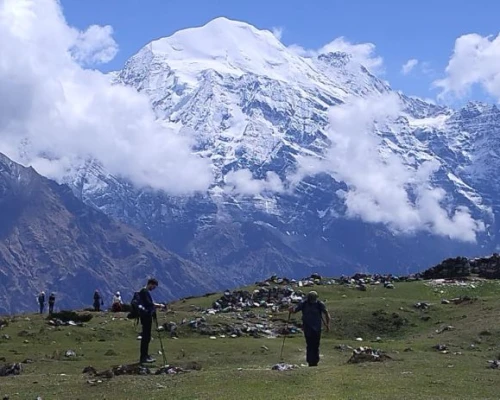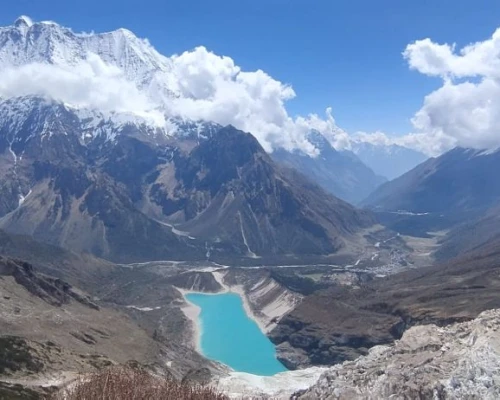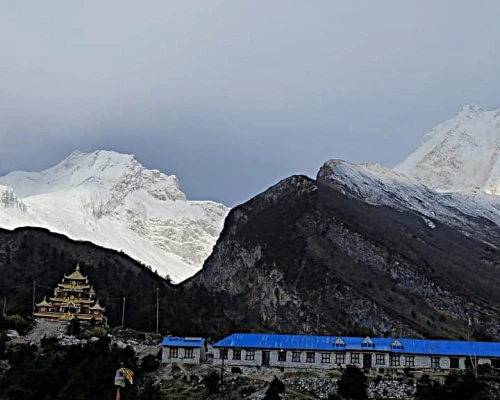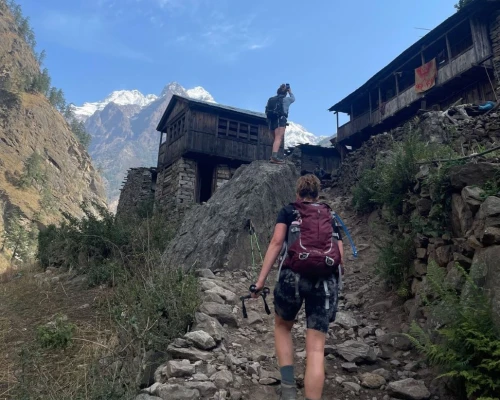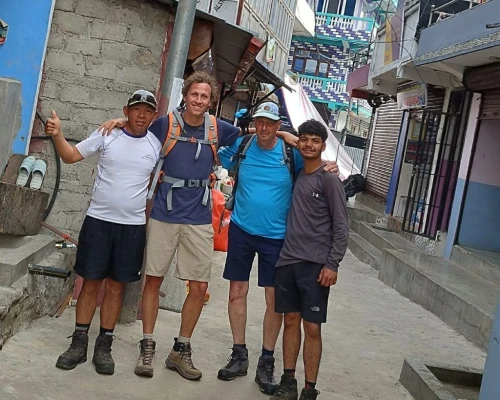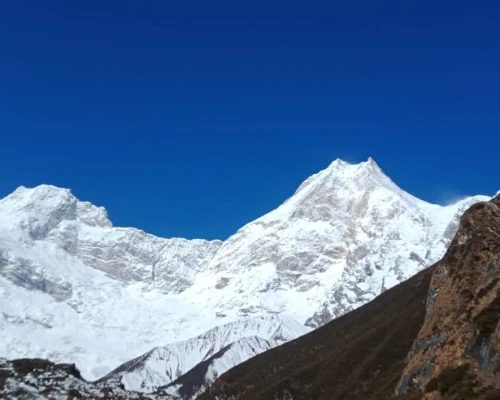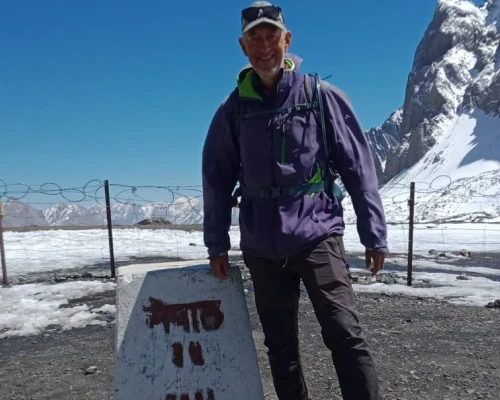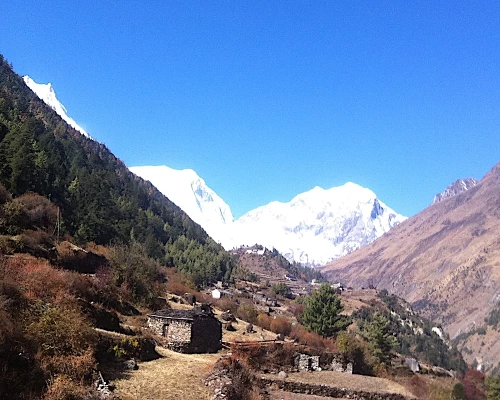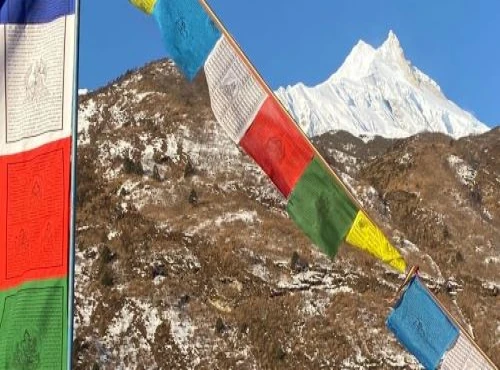Accommodation in Manaslu Circuit Trek for 2026-2027
The Manaslu Circuit Trek is a premier tea house trek in Nepal, offering a unique and challenging alternative to the famous Annapurna Circuit Trek. The trek offers many accommodation options, including teahouses and camping sites.
In Kathmandu, trekkers can find a variety of accommodations, ranging from basic hostels to luxurious 5-star chain hotels. The Hyatt Hotel Kathmandu is a popular choice among trekkers. In the package, we will provide you three-star standard hotel. You have to pay the additional cost if you want an upgraded hotel.
As the trek progresses, trekkers will come across various teahouses that offer basic facilities, including food and rooms. These include the ABC Guest House, Fulbari Guest House, Green Valley Guest House, Tsum Valley Guest House, Satkar Guest House in Soti Khola, and the Tsum Valley Guest House, Larkey Guest House, and Everest Guest House in Maccha Khola. Additionally, many of these teahouses also offer Wi-Fi and phone services for communication.
Moreover, in Jagat, trekkers can choose from the Jagat Guest House, Himalayan Tourist Guest House, Manaslu Santi Guest House, and Rubii Nala Guest House, which all offer wifi and satellite phone facilities.
In Deng, trekkers will find the Windy Valley Guest House, Sangrila Cottage, and New Manaslu Guest House, which offer Wi-Fi services but do not have hot showers.
In Namrung, trekkers can choose from the Namrung Thakali Guest House, Namrung Guest House, and Nubri Four Season Resort, which offer hot showers and wifi services.
In Lho, trekkers can choose from the Majestic Manaslu, Tashi Dalek Guest House, Namaste Guest House, and Lama Guest House, which offer Wifi, satellite phones, and hot showers.
In Sama Gaun, trekkers can choose from the Mount Manaslu Guest House, Tashi Dalek Guest House, Sama Gaun Guest House, Peace Heaven Guest House, Norling Guest House, Nobri Valley Guest House, and Gurung Cottage Guest House, which offer Wifi, satellite phones, and hot showers.
In Samdo, trekkers can choose from the Yak Hotel, Tibetan Twin Hotel, and Jambala Guest House, which offer Wi-Fi services only. Finally, in Dharmasala, trekkers can choose from the Jambala Guest House and Larkey Guest House, which provide essential assistance with no wifi or hot shower facilities.
During peak seasons, accommodation costs for the Manaslu Circuit range from US $3 to US $5 in lower altitude regions. However, as altitude increases, the cost of accommodation increases, reaching a range of US $7 to US $10. In off-season periods, accommodation in lower altitude regions can be found at US $2 to US $3. As the altitude increases, the cost of accommodation also increases, reaching a range of US $5 to US $7.
Meals Prices in 15 days Manaslu Circuit Trek for 2026-2027
Due to its remote location in Nepal, the Manaslu region's food cost is generally more expensive than in Kathmandu, and the menu options are limited. It is important to note that, as with other base camps in Nepal, food costs increase with elevation due to transportation challenges in higher elevations and remote areas.
From Sotikhola to LarkePass, supplies are primarily transported by men and mules, highlighting the effort and logistics involved in providing food in the region. Budgeting approximately USD 5-7 per meal is recommended, with a daily estimate of USD 20- 25. This may vary depending on individual appetite and beverage choices. Additionally, it is worth noting that breakfast is typically less expensive than lunch and dinner. Compared to other base camps such as Annapurna, Manaslu's food cost is relatively similar, with Everest being the most costly option.
Many tea houses also feature a restaurant offering (pseudo) continental cuisine, which may be selected from the menu. Typically, vegetables served in these establishments are sourced from their organic gardens. It is important to note that not all locations may offer options for meat, such as chicken, mutton, or pork, and beef is generally not available. If meat is provided, first confirm with a guide the freshness of the meat before placing an order. Due to the altitude and weather conditions, raising animals for consumption and storing meat can be challenging. To ensure safety, consult with a guide before ordering.
However, tea houses have some demerits with not readily available during all stages of the journey, so bring an additional energy source, such as energy bars or chocolate. The traditional Nepali dish "Dal Bhat power for 24 hours," which includes unlimited rice, is a popular option for those who need carbohydrates during their trek. While the food and water in the area are generally clean, exercise caution when purchasing local food or drinking water.
Guide and porter are the heart and soul of every trek.
Drinking water Costs increase step by step in Manaslu Circuit Trek
The cost of refreshments such as tea, coffee, and beer on the Manaslu Circuit Trek is similar to other mountainous areas. Yet, it is slightly more costly when compared to the expense of the same in the Everest Base Camp. This is owing to the utilization of cost-effective modes of food transportation, such as mules, donkeys, and yaks, as opposed to the reliance on helicopters and yaks in the EBC. A cup of tea in this region generally ranges from USD 2.5 to 4, a cup of coffee from USD 3 to 5, a 600ml bottle of beer from USD 5 to 8, and a bottle of water or soda from USD 2 to 5.
Regarding drinking water in the Manaslu Region, bottled water is readily available in settlements at roughly NPR 200 (USD 2) at lower elevations and NPR 400 (USD 4) at higher elevations. However, many trekkers use water purification drops, tablets, or a water filter to save money. We offer free water purification tablets to our customers, so be sure to ask for them when visiting our office.
You don't need to carry more than one or two liters of water during the day, as water sources are typically available every one to two hours of walking distance. The water in the mountains is free from pollution and is usually safe to drink. However, use water purification drops to add more safety. Stay hydrated at these high and low elevations and aim for a t east of 4-6 liters of water per day. Be sure to carry a water bottle that can hold hot and cold water.
Ethnicity and Diversity of Manaslu Circuit or Round Trek- 15 days
Nepal boasts a rich tapestry of ethnicity and diversity, home to over 26.5 million individuals representing over 40 different races and tribes. The country offers a unique blend of cultures, with lifestyles ranging from the ancient and traditional, found in the far west and high hills, to the modern and cosmopolitan, located in the bustling capital of Kathmandu.
The Manaslu region is primarily inhabited by two ethnic groups: the Nubri and Tsum. The branching marks divide these two ethnic domains off the river at Chhikur. While the Nubri has been frequently visited since Nepal opened itself to tourism in 1950, the Tsum have primarily retained their traditional culture, art, and traditions.
In the central hills of the region, the leading ethnic group is the Gurungs, many of whom have joined the Gurkha army in large numbers. Closer to the border with Tibet, the Bhutias, akin to the Sherpa group of Tibetan ethnicity, dominate the landscape, as can be discerned from their distinctive flat-roofed houses. They are predominantly Buddhist, and the region is dotted with austere monasteries, mani walls, chortens, and other Buddhist religious landmarks. The traditional faith of non-violence and compassion augments the wildlife diversity of the region.
The culture of Manaslu is shaped by the blending of Tibeto-Burman and Indo-Aryan customs, inherited from both northern and southern influences and further developed by the influences of the land, climate, and available resources. Overall, the Manaslu region offers a unique and authentic cultural experience steeped in tradition and history and reflects Nepal's rich and diverse cultural heritage.
Diversity in Flora and Fauna of Manaslu Regions
The Manaslu Circuit Trek is a veritable treasure trove of biodiversity, with a wide variety of flora and fauna that are sure to captivate the attention of any nature enthusiast. The region will encounter three distinct types of fauna unique to different altitude ranges. From the low hills' lush vegetation to the high mountains' alpine meadows, the Manaslu Circuit Trek offers a diverse array of flora that is sure to delight.
Among the trek's highlights is the presence of 19 different types of forests, dominated by the majestic rhododendron forests and the Himalayan blue pine. In addition to these more giant trees and plants, the region likewise boasts a wide variety of smaller plants, including medicinal herbs and mountain flowers that can be found even at high altitudes. The aromatic plants in the area also add to the overall sense of freshness and tranquility that one can experience on the trek.
The Manaslu Circuit Trek is also home to a wide variety of wildlife, including some of the world's most endangered and beautiful animals. The highlights of the wildlife in Manaslu will undoubtedly be the nearly extinct species of Red Panda and Snow leopards. Other beautiful animals n the area include the grey wolf, Asian black bear, blue sheep, Himalayan musk deer, tahr, mainland serow, woolly hare, horseshoe bat, Himalayan goral, Black-lipped pika, and Himalayan mouse-hare. There are also over 110 species of birds, 33 species of mammals, three reptiles, and 11 species of butterflies.
In recent years, conservation efforts have been going to protect Manaslu's majestic wildlife, with the region being declared a conservation area. These efforts have led to a resurgence in animals such as the snow leopard, grey wolf, Himalayan Thar, blue sheep, and musk deer, making it an even more exciting destination for wildlife enthusiasts.
Sustainable Manaslu Circuit Trek Routes
Manaslu Circuit Trek is about more than just experiencing the natural and cultural wonders of the region. It is also about treading lightly and responsibly to preserve the area for future generations to enjoy. That's why the trek is designed with sustainable tourism practices in mind, to ensure that the local communities and environment are protected and respected.
From using eco-friendly lodges and supporting local businesses to practicing Leave No Trace principles and respecting cultural customs, the Manaslu Circuit Trek is a true embodiment of sustainable travel. It is a journey that allows you to experience the beauty of the Himalayas and contribute to its preservation.
- You can start sustainable trekking by choosing your routes carefully. Planning your route is essential for eco hiking, and it's worth considering alternatives where there'll be less traffic while still sticking to pre-existing paths to avoid trespassing privately-owned land and protect local habitats.
- Secondly, avoid making a fire while trekking. While it can be tempting to make a fire to keep warm, it's essential first to check if it's permitted on the land you're exploring and consider the impact on the environment, especially if the landscape is particularly dry.
- Thirdly, choose sustainable outdoor clothing. Instead of using fast fashion, research to find sustainable outdoor clothing brands made from recycled materials and sourced responsibly. Invest in sustainable hiking boots, jackets, trousers, and more.
- Fourthly, choose eco-friendly snacks and drinks. To reduce your impact on the environment, select food and beverages that are locally sourced and take a refillable bottle to minimize single-use plastics. Lastly, don't leave a trace. Leftover rubbish can be incredibly harmful to the local ecosystem, so take biodegradable bin bags with you to ensure proper waste disposal. Additionally, when setting up camp, avoid moving any vegetation and opt for a spot that is naturally clear for you to set up camp.
By following these sustainable hiking tips, we can all ensure that the Manaslu Circuit Trek remains a beautiful and pristine destination for generations to come.
Essential Manaslu Circuit Trek Permits for 2026-2027
The Manaslu Circuit trek, located between the villages of Jagat and Dharapani, has been declared a restricted area by the government to preserve the region's natural beauty and cultural heritage. Now solo trekkers are not allowed, and all other trekkers in a group must get a special entry permit through a registered agency.
The government has established specific guidelines for trekkers to ensure the region's safety and proper management of tourism. These include a minimum group size of two trekkers, accompanied by a local guide, and the requirement for all permits to be processed through a registered agency. Freelance guides are not authorized to issue permits for the Manaslu Circuit.
Three different permits are required for the Manaslu Circuit trek:
- The Special Restricted Area Permit (Manaslu RAP)
- The Manaslu Conservation Area Project (MCAP) permit
- The Annapurna Conservation Area Project (ACAP) permit
An additional permit is required for those who merge their trek with the Tsum Valley trek.
Manaslu RAP:- The Manaslu RAP permit is required from Jagat until the trekker crosses Sama Gaun. The price for the license varies depending on the number of days spent between Jagat and Dharapani, with a cost of USD 100 per person for the first seven days and an additional USD 15 per person per day from the eighth day onwards between September and November. The cost is less between December and August, at USD 75 per person for the first seven days and an additional USD 10 per person per day from the eighth day onwards. A printed photograph is not required for the RAP permit, as it will be uploaded online and published on the license itself.
MCAP permit:- The MCAP permit is required from Philim, where the Manaslu Conservation Area starts. The cost is a flat rate of USD 30 per person, and there is no restriction or change in price based on the number of days spent inside the MCAP. A printed photograph is required for the MCAP permit.
ACAP permit:- The ACAP permit is required from Dharapani until the trekker exits the ACAP in Beshi Sahar. The cost is also a flat rate of USD 30 per person, and there is no restriction or change in price based on the number of days spent inside the ACAP. A printed photograph is also required for the ACAP permit.
After obtaining the RAP, MCAP, and ACAP entry permits, getting a TIMS (Trekkers Information Management System) card is only needed if the trekker is heading toward the Annapurna Circuit from Dharapani. The government's strict regulations on permits and guides for the Manaslu Circuit trek are in place to ensure the preservation of the region's natural and cultural treasures for generations to come.
Baggage and weight limit for porters in Manaslu CIrcuit Trek all Inclusive Package
The Manaslu Circuit trek is a challenging journey that requires proper planning and preparation. One crucial aspect to consider is the baggage and weight limit for porters.
Observing and complying with the established protocols is compulsory to guarantee a secure and triumphant trek. The porters, who will be transporting your duffle bag, are held accountable for carrying to a weight limit of 22 lbs. This restriction has been implemented to safeguard the health and welfare of the porters, who will be carrying the load at elevations and over extended distances.
However, porters are not responsible for carrying your daypack, which should contain any necessary clothing and personal belongings for that day.
Packaging efficiently and strategically when preparing for the Manaslu Circuit trek is essential. Consider the weather and the altitude, and pack accordingly. Avoid packing unnecessary items and focus on the essentials, such as warm clothing, a waterproof jacket, comfortable hiking shoes, and necessary personal items.
To ensure a smooth and successful trek, communicate with your porter and ensure they understand the weight limit and the items packed in the duffle bag. Likewise, treat the porters with respect and kindness as they provide your safety and comfort throughout the trek.
Transportations Options for 15 Days Manaslu Circuit Trek
The Manaslu trek in Nepal can be accessed by driving to the starting point of the trek in Arughat town. One way to reach Arughat 550 m / 1,805 feet is by driving from the main historical town of Gorkha, passing through several farm villages, to Khan-Chowk and then Arughat. Another route is from Kathmandu via Malekhu town, across the Trisuli River, to Dhading-Besi, and then Arughat. At Arughat, one needs to switch to a local vehicle suitable for the rough dirt road for a few hours' drive to the Soti-Khola, located at an elevation of 700 m/2,296 feet.
- Transportation by Local Bus
The journey via local bus from Kathmandu may initially seem daunting, with the potential for overcrowding. However, the experience proves to be an intriguing and enlightening as the bus makes various stops to pick up and drop off passengers and refresh at local restaurants.
As the journey progresses, the bus traverses the district of Gorkha, located in the Mid-West of Nepal between the majestic peaks of Mt. Manaslu and Ganesh Himal. This cost-effective mode of transportation offers the opportunity to immerse oneself in the local customs and culture while providing a front-row seat to the breathtaking changes in the landscape.
Indulge in the luxury of private transportation as you embark on your journey to your destination. The cost may be substantial, but the experience is well worth it. The private Jeep at your disposal offers the opportunity to stop and capture memories along the way and the option to dine at a delightful restaurant en route. The spacious seating arrangement, expert driver, and ability to navigate various road conditions ensure a comfortable and timely arrival. For those venturing beyond the main town of Arughat, the four-wheel drive capability provides a smooth ride even on rough and bumpy dirt trails.
The journey to Manang and Manaslu has now been made accessible by motorable roads, allowing trekkers to indulge in a scenic drive to Besisahar, the headquarters of the Lamjung district. This drive can be taken via a local jeep, which can be bumpy on winding dirt hilly tracks, but a thrilling experience from the Chamje village.
A private jeep ride from Dharapani or Chamje village can be arranged for a more comfortable and faster option. This drive offers comfortable seating arrangements and leads you through winding downhill routes above the Masrsyangdi River, past the Jagat village, and further down to Syange village. From here, the journey continues on good dirt roads to Besisahar, offering a chance to enjoy the ride and the beautiful landscape scenery.
For those traveling from Besisahar to Kathmandu, a local bus is available that departs in the morning and late afternoon. The journey takes more than 5 hours, covering a distance of 186 km or 115 miles, with frequent stops for passengers and refreshment breaks. The bus also has different classes of seats, with the best seats being in the front and behind the driver, offering more legroom. A private jeep or car can be arranged for a more comfortable and faster option, with the drive leading to a journey of great comfort and observation of exciting views.
Guides and porters safety and security in Manaslu
Trek also poses certain risks to the safety and security of both guides and porters.
Guides and porters play a crucial role in ensuring the safety and well-being of trekkers. They are responsible for navigating the challenging terrain, providing information on local customs and culture, and ensuring that trekkers have adequate supplies. Guides and porters must be adequately trained and equipped to handle the unique challenges of the Manaslu Circuit Trek.
One of the critical risks associated with the trek is the potential for altitude sickness. Guides and porters must be familiar with the symptoms of altitude sickness and know how to respond appropriately. They should also be able to identify other potential health hazards, such as hypothermia, frostbite, and dehydration.
Proper equipment is vital in ensuring the safety and security of trekkers on the Manaslu Circuit. To guarantee readiness for the demanding terrain, guides, and porters must possess the necessary attire, footwear, and provisions. Additionally, proficiency in using emergency equipment such as radios and satellite phones and knowledge of emergency protocols is vital in unforeseen circumstances.
Likewise, ensure your guides' and porters' safety and security by familiarising them with the potential risks in the remote and isolated areas traversed during the trek. Equip them with knowledge of local laws and regulations and provide them with emergency response training to ensure they are prepared to handle any situation that may arise.
As guides and porters, they must not only lead the way but also safeguard the well-being of trekkers. They are experts in local customs and culture and are committed to ensuring that trekkers are knowledgeable and respectful of the communities they encounter. Additionally, they are dedicated to promoting environmental conservation and educating trekkers on the importance of leaving no trace.
International Travel Insurance
Travel insurance is vital for any international trip, especially for a trek like the Manaslu Circuit. Not only does it protect against unforeseen events, but it also gives you peace of mind knowing that your vacation investment is protected.
Firstly, Travel insurance can reimburse prepaid, non-refundable trip expenses in case of a covered cancellation. This can include situations such as the severe illness or injury of the insured individual, a traveling companion, or a family member; the passing of the insured traveler, a companion, or a family member; or natural disasters or other occurrences that make the destination unoccupiable.
Imagine paying $7,000 for a once-in-a-lifetime luxury trek for your 25th wedding anniversary and canceling the day before venturing due to a family emergency. Travel insurance can provide financial protection in such situations.
Secondly, medical emergencies can be costly. Imagine being in a car accident while on a driving tour and having a broken leg and other serious injuries. Many medical facilities require cash payment upfront and do not accept insurance plans. Investing in a comprehensive travel insurance plan that includes emergency medical benefits can provide peace of mind while on your journey. In the event of a covered medical or dental emergency, you can rest assured that your expenses will be covered, allowing you to focus on your recovery. Additionally, the emergency medical transportation benefits offered through this type of insurance can ensure that you are transported to the most appropriate medical facility for your needs and that the cost of returning home following a covered injury or illness is taken care of.
Thirdly, minor mishaps can ruin your trip. A vacation is an investment in your happiness, and when a canceled flight, a missed connection, a missing bag, or another travel hiccup occurs, that happy travel feeling fades. Investing in travel insurance can provide a sense of security and peace of mind during unexpected travel hiccups. The travel delay benefit allows for reimbursement of additional expenses, such as accommodation and travel, and lost prepaid costs resulting from a covered departure delay of six hours or more. The baggage delay benefit offers reimbursement for the necessary purchase of essential items during your trip if your luggage is postponed or misdirected by a common carrier for 24 hours or more.
Lastly, many travel agencies in Nepal recommend travel insurance. The agency's powers are limited, and they cannot pay for your medical care, transportation, or other expenses. With travel insurance, you have access to a 24/7 hotline staffed by professionals who can assist with emergency medical care, transportation, and additional costs.
Chances of Altitude sickness and prevention in Manaslu Circuit Trek in 5106 meters ?
Located at an elevation of 4800 meters, the base camp of Mt. Manaslu presents a formidable challenge to trekkers, with daily elevation gains averaging between 400-500m. One of the biggest obstacles to overcome is the body's ability to adjust to the high altitude.
As we ascend, the air becomes increasingly thin, increasing the risk of altitude sickness. Altitude sickness can affect anyone, regardless of factors such as age, gender, or fitness level.
Symptoms of altitude sickness include headaches, fatigue, loss of appetite, and more.
Taking a break and rest if you start experiencing any symptoms at high altitudes is essential. Proper acclimatization and rest are crucial for successfully navigating higher elevations. Ignoring signs can lead to severe conditions such as HACE and HAPE and even fatal if not treated promptly. If you experience symptoms, the best course of action is to descend to a lower altitude. Strolling, taking regular breaks, and drinking plenty of water are essential to prevent altitude sickness. Drinking onion soup is also known to be effective in preventing altitude sickness. With proper precautions and attention to your body's needs, you can safely complete the Manaslu Circuit trek.
The Manaslu Circuit trek takes trekkers through a diverse range of landscapes and elevations, starting at 710 meters and reaching the highest point of Larkya La Pass at 5213 meters. However, as the altitude increases, so does the risk of altitude sickness.
Gears to pack For Manaslu Circuit Trek
Preparing for the Manaslu circuit trek can be a daunting task, particularly when it comes to selecting the right items to pack. As you traverse through an array of elevations, ranging from 600 meters at Soti Khola to a staggering 5,179 meters over the Larke Pass, you must consider the varying weather conditions you may encounter. A well-planned and thoughtfully curated packing list is crucial to ensuring a successful and enjoyable trekking experience.
As you prepare for your trek in the Manaslu Region, be mindful of the items you choose to pack. Overpacking can lead to a lack of space for essential items and unnecessary weight on your journey. Many trekkers have reported regretting the purchase of unnecessary items for their trek.
The option to purchase or rent gear in Kathmandu is available. This includes down jackets, tents, backpacks, and shoes.
It is advisable to leave any unnecessary items, such as souvenirs, at the hotel before embarking on the Manaslu trek. This is because it is a circuit trek, and it is impossible to leave items along the way and expect to retrieve them on the return journey. It is best to leave everything in Kathmandu. A comprehensive packing list for the Manaslu region should include sun protection, as the days in Nepal are often sunny for approximately 300 days out of 365. Many underestimate the sun's power but protect yourself from its harmful rays to avoid regretting it later.
When embarking on a trek at higher altitudes, it is essential to have the proper gear to keep you warm and comfortable. Headwear, such as a warm hat and a buff, can be used for multiple purposes, such as keeping your neck warm and protecting it from sun, wind, dust, and bugs. Bodywear, including underwear and sports bras made from moisture-wicking materials, is crucial for preventing chafing and staying dry throughout the day. A base layer, trekking shirt, fleece jacket, and outer jacket are also necessary for insulation and protection from the elements. Handwear, including inner and outer gloves, and footwear, such as hiking socks, thermal socks, hiking boots, and gaiters, are also crucial for keeping your feet warm and protected. Lastly, carrying a duffle bag or backpack and a daypack for essentials is recommended to make the trek as comfortable as possible.
Tipping for guides and porters in the Manaslu circuit trek or in Nepal
Regarding tipping in Nepal, there are a few essential things to remember. Firstly, it is unnecessary to tip, but if you choose to, you should give at least Rupees 100 (less than USD 1) to bell boys or hotel cleaners. For a 5-day trek, it is suggested to provide at least USD 10 per day to the guide and USD 7 per day to the porter. The recommended amount for tipping can vary depending on the duration and difficulty of the trek, and some travel agencies suggest a 10% tip of the total travel package value.
When trekking for a week or two, it is recommended to tip USD 100+ for the guide and USD 70 for each porter. For treks lasting longer than two weeks, or those that involve high altitude or 5000m mountain passes, it is suggested to tip the guide USD 150 or more and the porter USD 90. For climbing peaks in Nepal, it is recommended to tip USD 200-250 to the climbing guide.
In addition to cash tips, it is also acceptable to leave behind any trekking gear that you no longer need as a way to show gratitude. When giving tips, it is best to do so on the last evening of the trek and to provide the tips to the guide and porter separately. The people who are typically expected to receive tips in Nepal include:
- Trekking staff (guide, cook, helper, and porters).
- Climbing guides and supporters.
- Hotel staff, such as bellboys and cleaning ladies.
It is important to note that taxi drivers should have their fares pre-negotiated. A 10% service charge in restaurants is usually added to the bill, so tipping is unnecessary.
As a Nepal traveler, you can tip in currencies such as USD, EURO, AUD, SGD, POUND, and CAD. These currencies can easily be exchanged at money changers, banks, or for NPR (Nepalese Rupees). However, for those not located in urban areas, it may be more convenient to tip in Nepalese Rupees. This eliminates the need for currency exchange and allows easy withdrawal at ATMs in Kathmandu, Pokhara, or nearby money exchange counters.
Avoid certain behaviors like Showboating your generosity and kindness when tipping, as it is not appreciated. Additionally, giving worn-out and old clothes or goods can be considered insulting to the person receiving them. Lastly, avoiding tipping too little, such as notes below Rs, is essential. 100 (USD 1) to your guide and porter. This can be seen as disrespectful and may offend.





